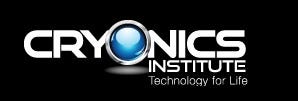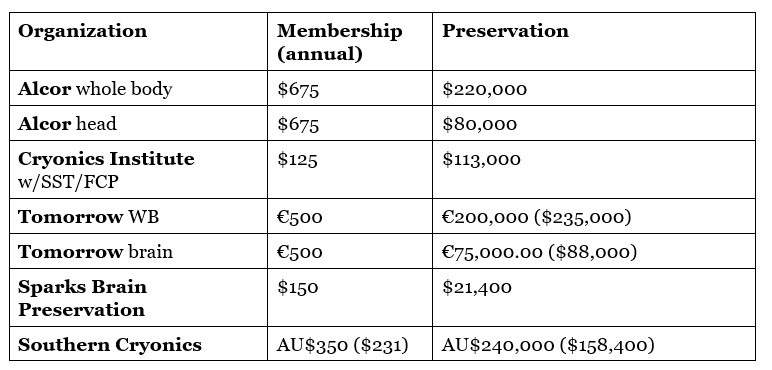The Total Cost of Biostasis
An apples to apples comparison of biostasis organizations
This is an updated and expanded version of the essay originally (and briefly) published.
Biostasis may or may not work. You cannot estimate the probability that it will work for you with any precision or certainty. Even so, you have decided that it is worth a shot. Passively letting your life come to an end does not appeal to you. Perhaps anti-aging research will bear fruit and lead to available treatments in time for you. But maybe not. And you could be killed by disease, accident, or misadventure. So, you are going to make arrangements to be cryopreserved – or possibly take advantage of a different form of biostasis.
How much will your choice cost? The basic charges for services by each organization are mostly fairly straightforward. Things get more complicated when you consider the different options offered by cryonics and other biostasis organizations. Some of the most cited numbers do not include everything you will need (or should want).
Are you covered for standby, stabilization, and transport (SST)? Without it, you are likely to suffer extended delays before being cryopreserved, resulting in increased damage.
Does the quoted number for cryopreservation include the cost for a funeral director to arrange transport to the cryonics organization?
Will you need to pay an international surcharge?
If you are signing up someone else – or you delay too long so that someone else has to sign you up – is there an extra charge?
Can you save money by relocating close to your cryonics organization?
This essay concludes with a cross-organization comparison of costs, making the most common assumptions including the need for SST.
I want to emphasize that the amounts quoted are minimums. Inflation exists! You should plan to fund future increases in minimum required funding.
Let’s take a look at five organizations:
Alcor Life Extension Foundation
Membership dues: Alcor adopted age-based dues, so that you pay more the older you are. The idea being that young people will be paying for more years and so should pay less per year.
For people 1-17 years the annual dues are $60.
For turning 18, the dues are $200/year.
From age 19 on, the dues are determined by the formula: Current age x $25. (For example: 30 years old at sign-up = $450/year. 60 years: $900; 80 years: $1,200)
Cryopreservation cost: Alcor offers two main options: Whole body preservation and “neuro” preservation (head only). The minimum for whole body is $220,000.
International surcharge: Add $10,000 if you live outside the USA and Canada.
Third-party signups. $25,000 for a member signing up a non-member. $50,000 for a non-member signing up a non-member. (This is to hedge for legal risk when someone does not sign themselves up.)
Relocation incentive: Alcor offers up to $10,000 for people who relocate to the Phoenix/Scottsdale area. If you are local, Alcor will save more than that among on SST and you will benefit from a faster response.
Of the total amount paid for cryopreservation, a specific amount is allocated to SST: $135,000 for whole body, $25,000 for “neuro.”
Apply or view your member on the member portal.
Cryonics Institute
info@cryonics.org
Membership dues: There are two options: A lifetime membership or annual dues payments. For people not expecting to need CI’s services for more than ten years, the lifetime option is a good deal.
Annual: $125 + $75 initiation fee.
Lifetime: $1,250. (No initiation fee.)
Cryopreservation cost: The cost of perpetual cryonic suspension for a Lifetime Member is $28,000 or $35,000 for Annual Members. Neither includes “local help” which seems to mean funeral director costs. These may be lower if you live near CI. They may be $3,000-$5,000 more on the west coast. Overseas they may be considerably more.
Last-minute cases (if accepted) pay a higher fee of $45,000. Membership: $1,250. No additional charge is listed for third-party sign-ups.
Human cryopreservation prices do not include “Standby Help”, which can range from $500 to $100,000 depending on distance from CI and options such as SA, ICE, or air ambulance. Determining SST costs is a little complicated. CI does not provide non-local SST so members need to make arrangements with either Suspended Animation (SA) or International Cryomedicine Experts (ICE).
International Cryomedicine Experts: ICE offers consulting services for $15,000, SST for $50,000, and SST plus surgery and perfusion for $80,000. SST includes 96 hours of standby, with additional days at $2,750. The total for a lifetime member would be $28,000 + $80,000 = $108,000, not including additional standby days.
There is an international fee of $12,500 for cases in Canada and $25,000 for all cases outside of the USA and Canada. The total for an international case for a CI lifetime member without additional standby days is $28,000 + $80,000 + $25,000 = $133,000.
Suspended Animation: Six options are listed These depend on whether you want:
SA offer three basic options (plus the CI cryopreservation fee as above). Insured Plan ($48,000), Prepaid Flat-Rate Plan ($45,500), and Prepaid Incremental Plan ($27,500).
The first two options cover you for two standbys with unlimited standby days “only while a Serious Risk prevails.” The last option covers you for only one deployment of up to 72 hours. It would be prudent to provide for extra days and more than one standby. plus a fee for additional days of standby.
There is an additional $30,000 “completion fee” – the actual stabilization and transport.
SA’s prices have gone up recently but that is because CI members with SA arrangements now get SST and field cryoprotection (cryoprotection before being transported to the cryonics organization). The field cryoprotection part of the fee may be refundable if not used.
If you are considered to have signed up at the last minute – the exact time interval is not specified – you will be charged an additional $20,000 fee.
Given all the above options, there is no simple answer to the total cost of SST and cryopreservation at CI. If we assume a USA-based member with the Insured Plan ($48,000) with completion fee ($30,000) and cryopreservation fee for lifetime member ($28,000) then the total is $106,000.
Both SA’s and ICE’s services may be covered through life insurance.
Tomorrow Biostasis
Membership dues: €50/month. €500/year. €9,999/lifetime. (As of Sept. 23, 2025, 1.00 Euro is equivalent to about $118. These rates are fixed in USD for existing members and will be updated to reflect EUR/USD for new members. (inflation adjustment is extra.)
Cryopreservation cost:
Member:
€200,000.00 WB ($235,000)
€75,000.00 Brain only ($88,000)
Non-member:
€230,000 WB ($270,000)
€115,000 brain ($135,000)
Funding through insurance: You can calculate your amounts on the website.
Premiums can be as low as $30.00 per month (whole-body) or $7.00 per month (brain-only). This is the lowest TB’s life insurance partner can go for young people without health issues and using term insurance. The pricing depends on your age and health. You should be aware that term insurance, while relatively cheap, is not a long-term solution. If you want to start with term, try to get a policy that can be converted to permanent insurance without a medical exam.
There are no additional charges for SST or anything else.
Sparks Brain Preservation
SBP provides chemical preservation, not cryopreservation. The only exception is that they accept cases where a “straight freeze” has been necessary. Sparks sees chemical fixation as superior to cryopreservation but this is highly controversial in the field. Chemical fixation is a form of biostasis so we include it here.
Preservation prices vary considerably depending on your location and whether you want to preserve your brain or your whole head.
Membership in SBP is $150 per year. Membership dues paid contribute to the cost of your preservation (staff, travel costs, and funeral home services). Members of two+ years standing receive 33% off all prices, including standby.
There is no charge for the procedure or for storage. This is possible because SBP is funded by founder Jordan Sparks. You will need to consider the cost of getting yourself or your brain to SBP.
If you are able to take advantage of Oregon’s Medical Aid in Dying laws and can get yourself to SBP, you can undergo legal death (by independent physician) in the visitor room for only $2,000 (3000 for non-members or new members). This fee is waived for research program participants.
Charges depend on distance. From SBP’s website:
Driving distance:
Oregon - Within 75 miles of Salem: $2800 ($4200 for non-members or new members)
Oregon - Within 150 miles of Salem: $3500 ($5250)
Oregon - Elsewhere in the state: $6200 ($9300)
Washington - Within 150 miles of Salem: $4100 ($6150)
Washington - Seattle Area (including Bellingham): $5500 ($8250)
Washington - Elsewhere in the state: $6200 ($9300)
Flying distance:
Pacific Time Zone: $11,600 ($17,400)
Mountain Time Zone: $12,300 ($18,450)
Central Time Zone and Alaska: $13,000 ($19,500)
Eastern Time Zone and Hawaii: $13,600 ($20,400)
Standby services, if needed, come with a separate charge. Each day of standby costs $2,800 per day ($4200 for new members or non-members). There is a distinct price list for “standby-only deployment” which means cases in which a team is deployed preservation is not carried out. Costs range from $4600 ($6900 for new members or non-members) in the Pacific Time Zone to $6600) ($9900) in the Eastern Time Zone and Hawaii.
If, out of choice or necessity, you have to be transported to SBP before the procedure can begin there will be a charge of $2800 ($4200 for non-members) plus the funeral director’s fee.
There are also prices for a straight freeze cryopreservation in cases where the standard procedure is not possible: $5000 for cryopreservation only of the brain only ($7500 for non-members) or $15,000 ($22,500) for cryopreservation only of the entire head
Southern Cryonics
Membership dues:
Adult: AU$350 per year
Child age 12–18: AU$175 per year
Child under age 12: free
CRYONIC SUSPENSION FEE. This once-only fee covers your cryopreservation procedure and the ongoing storage requirements for the entire period that you remain in suspension. This fee does not cover SST services prior to your cryopreservation.
AU$150,000 for a Subscriber
AU$170,000 for a non-Subscriber
SST services estimates. “This estimate covers the specialized Standby, Stabilization and Transportation (SST) services that are needed prior to being suspended at Southern Cryonics. Your SST costs will vary according to location, and are incurred by CryoPath (or a provider of your choice) at the time of suspension on a pay-as-you-go basis. Shown here are current estimates.”
Sydney/Canberra: AU$60,000
Melbourne/Brisbane: AU$70,000
Hobart/Adelaide/Perth/Darwin: AU$80,000
Bottom line comparison
Seeing all these options and varying pricing, you may be scratching your head. Too many variables! Can’t you simplify this complexity? Yes, I can. Just remember that your particular situations and preferred options may add up differently. The following bottom line numbers represent what I take to be most common and desirable options. I would not recommend any service that does not include standby, stabilization, and transport, so those costs are included for each organization.
Assumptions
All within-country.
Alcor: Member age = 45. Dues = the members age x $15.
CI: annual member with standby by Suspended Animation insured plan and (refundable) field cryoprotection and funeral director charge = $35,000 + $48,000 + $30,000 = $113,000.
Tomorrow: No assumptions needed.
SBP Central Time Zone $13,000 ($19,500 non-member) + 3 days standby ($8400). Less for long-term members.
Southern: AU$170,000 [$112,200] + SST (AU$70,000 [$46,200])
As one example of the importance of clarity about options, sometimes CI’s low-cost lifetime cryopreservation fee of $28,000/$35,000 is compared with considerably higher numbers from Alcor and Tomorrow Biostasis. But this is a misleading comparison because the latter two organizations include SST and even field cryoprotection. When you add in SST costs – as you really should – Alcor’s “neuro” and Tomorrow’s brain-only options cost less than a whole body cryopreservation by CI. SBP costs even less thanks to found Jordan Sparks financial support.
Conclusion
As you can see, you cannot pluck a single number from each organization to compare your real cost of getting cryopreserved. It is a little like comparing the size of cryonics organizations. The lowest-cost option would be brain preservation by SBP, even with remote standby. Next would be a lifetime membership with Cryonics Institute without standby, stabilization, and transport. A higher cost would be a whole body preservation with Alcor or Tomorrow Biostasis. The highest cost would be an international case with Alcor or Tomorrow.
I am not going to insist on there being any one right answer for everyone. (I am not even sure for myself at this time.) Take a clear-eyed look at the options and total expenses and decide what works for you.
SBP is an excellent deal IF you are comfortable with chemical fixation and expect this to be reversible or if you expect uploading to be possible and a form of survival and if you are not concerned about the lack of a fund to pay for the procedure.
Remember that a major portion of the fee by Alcor and Tomorrow Biostasis goes into a dedicated patient care fund. The lower price with Cryonics Institute does not have this feature, nor do any of the SBP options. (CI says that of the $28,000 or $35,000 cryopreservation fee, the $20,000 remaining after the procedure goes into very stable long-term investments, but these are not held separately from operational expenses.)
Once you have chosen an organization and figured out which options to pick, you can then look into life insurance or other means of funding your cryopreservation.
Besides asking questions about cryopreservation costs, you should also consider the degree of transparency each organization; how much funding they set aside to maintain patients in care and how that is managed.








